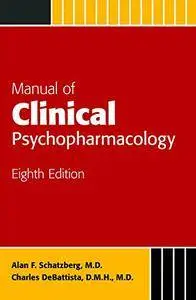Manual of Clinical Psychopharmacology (Schatzberg, Manual of Clinical Psychopharmacology) by Alan F. Schatzberg, Charles DeBattista
2015 | ISBN: 1585624810 | English | 795 pages | PDF | 5 MB
2015 | ISBN: 1585624810 | English | 795 pages | PDF | 5 MB
Standard of care in psychiatry requires that practitioners stay current on new agents, interactions, side effects, and dosing guidelines – a daunting task for the modern clinician grappling with today's challenging medical environment. The Manual of Clinical Psychopharmacology has been the psychiatrist's trusted companion for nearly three decades, and this new, eighth edition delivers the cutting-edge information clinicians need in a down-to-earth style, facilitating the integration of biological and psychopharmacological information into practice. The book's primary purpose is to provide the reader-practitioner with a practical, usable clinical guide to the selection and prescription of appropriate drug therapies for individual patients, drawing on the authors' clinical experience as well as on the scientific literature. Students of psychiatry and psychopharmacology also will find the book useful as both text and reference. The eighth edition retains many of its most popular features, while adding others to enhance coverage and promote comprehension: * Some sections dealing with less commonly used drugs (e.g., barbiturates) have been shortened or eliminated, making space for the huge number of new agents that have been approved (e. g., vortioxetine) or are likely to receive approval from the U.S. Food and Drug Administration (FDA). This makes the volume easier to use. * The book has been thoroughly updated to reflect the release of DSM-5, which introduced dimensional measures of key dimensions (e.g., anxiety and depression) across diagnostic categories to better describe patients' disorders. In the chapter on diagnosis and classification, the authors review these major changes and the implications for prescribing.* Features of particular utility for students include the introductory chapter on the general principles of psychopharmacological treatment and the summary medication tables, which serve as quick-reference guides on classes of psychotropics.* Although largely evidence-based, the authors also draw on their extensive clinical experience in discussing various drugs' efficacy, dosing and side effects and other important factors. * Two appendixes offer suggested readings for clinicians and for patients and families, as well as information on strengths and costs of antidepressant and antipsychotic drugs. There has never been a more meticulously researched and referenced guide to prescribing psychotropic medications, nor one more down-to-earth and practical. The Manual of Clinical Psychopharmacology richly deserves its reputation as a classic in the field and has earned a place on every psychiatrist's desk.



